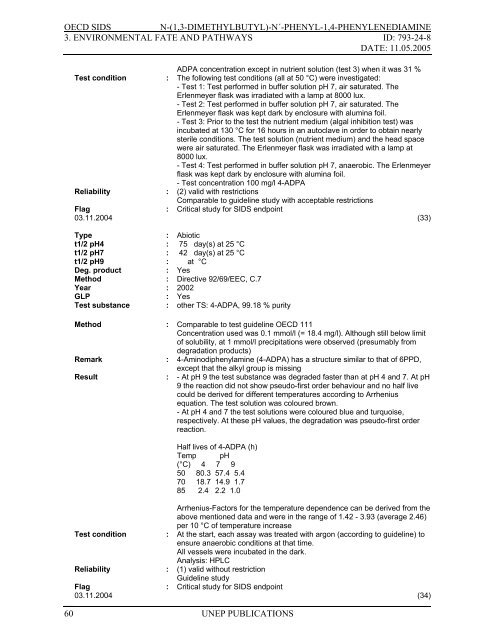N-(1,3-Dimethylbutyl)-N
N-(1,3-Dimethylbutyl)-N
N-(1,3-Dimethylbutyl)-N
Create successful ePaper yourself
Turn your PDF publications into a flip-book with our unique Google optimized e-Paper software.
OECD SIDS<br />
N-(1,3-DIMETHYLBUTYL)-N´-PHENYL-1,4-PHENYLENEDIAMINE<br />
3. ENVIRONMENTAL FATE AND PATHWAYS ID: 793-24-8<br />
DATE: 11.05.2005<br />
ADPA concentration except in nutrient solution (test 3) when it was 31 %<br />
Test condition : The following test conditions (all at 50 °C) were investigated:<br />
- Test 1: Test performed in buffer solution pH 7, air saturated. The<br />
Erlenmeyer flask was irradiated with a lamp at 8000 lux.<br />
- Test 2: Test performed in buffer solution pH 7, air saturated. The<br />
Erlenmeyer flask was kept dark by enclosure with alumina foil.<br />
- Test 3: Prior to the test the nutrient medium (algal inhibition test) was<br />
incubated at 130 °C for 16 hours in an autoclave in order to obtain nearly<br />
sterile conditions. The test solution (nutrient medium) and the head space<br />
were air saturated. The Erlenmeyer flask was irradiated with a lamp at<br />
8000 lux.<br />
- Test 4: Test performed in buffer solution pH 7, anaerobic. The Erlenmeyer<br />
flask was kept dark by enclosure with alumina foil.<br />
- Test concentration 100 mg/l 4-ADPA<br />
Reliability : (2) valid with restrictions<br />
Comparable to guideline study with acceptable restrictions<br />
Flag : Critical study for SIDS endpoint<br />
03.11.2004 (33)<br />
Type : Abiotic<br />
t1/2 pH4 : 75 day(s) at 25 °C<br />
t1/2 pH7 : 42 day(s) at 25 °C<br />
t1/2 pH9 : at °C<br />
Deg. product : Yes<br />
Method : Directive 92/69/EEC, C.7<br />
Year : 2002<br />
GLP : Yes<br />
Test substance : other TS: 4-ADPA, 99.18 % purity<br />
Method : Comparable to test guideline OECD 111<br />
Concentration used was 0.1 mmol/l (= 18.4 mg/l). Although still below limit<br />
of solubility, at 1 mmol/l precipitations were observed (presumably from<br />
degradation products)<br />
Remark : 4-Aminodiphenylamine (4-ADPA) has a structure similar to that of 6PPD,<br />
except that the alkyl group is missing<br />
Result : - At pH 9 the test substance was degraded faster than at pH 4 and 7. At pH<br />
9 the reaction did not show pseudo-first order behaviour and no half live<br />
could be derived for different temperatures according to Arrhenius<br />
equation. The test solution was coloured brown.<br />
- At pH 4 and 7 the test solutions were coloured blue and turquoise,<br />
respectively. At these pH values, the degradation was pseudo-first order<br />
reaction.<br />
Half lives of 4-ADPA (h)<br />
Temp pH<br />
(°C) 4 7 9<br />
50 80.3 57.4 5.4<br />
70 18.7 14.9 1.7<br />
85 2.4 2.2 1.0<br />
Arrhenius-Factors for the temperature dependence can be derived from the<br />
above mentioned data and were in the range of 1.42 - 3.93 (average 2.46)<br />
per 10 °C of temperature increase<br />
Test condition : At the start, each assay was treated with argon (according to guideline) to<br />
ensure anaerobic conditions at that time.<br />
All vessels were incubated in the dark.<br />
Analysis: HPLC<br />
Reliability : (1) valid without restriction<br />
Guideline study<br />
Flag : Critical study for SIDS endpoint<br />
03.11.2004 (34)<br />
60<br />
UNEP PUBLICATIONS
















